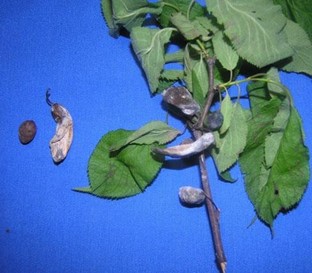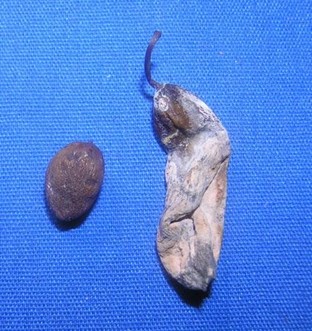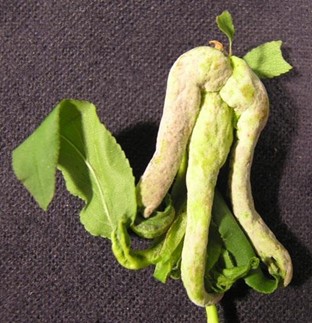Disease Notes
Contact
Plant Diagnostician
Phone: (479) 575-2727
Email: ssmith@uada.edu
Jason Pavel
Diagnostician
Phone: (479) 575-7257
Email: jpavel@uada.edu
University of Arkansas System Division of Agriculture
Cralley Warren Building
Room 16
2601 N. Young Ave.
Fayetteville, AR 72704
Plum Pockets
by Sherrie Smith and Jason Pavel

Plum Pockets – Taphrina communis
Photo by Sherrie Smith, University of Arkansas Cooperative Extension
Do you have abnormal growths on your plum tree?
Homeowners are sometimes startled to find abnormal growths instead of fruit on their plum trees. Plum pockets, also known as Bladder pockets or Mock plums, are the common names given to a fungal disease of plums caused by Taphrina communis. Leaves, stems, and fruit may be affected. However, the most noticeable symptoms are on the fruit.
What are the symptoms of plum pockets?
Symptoms appear about 6-8 weeks after bud break, with small blisters forming on the surface of the fruit. The fruit becomes thickened and distorted, growing to as much as ten times its typical size. The centers of infected fruits do not contain pits and are spongy or hollow. At first, the deformed fruit may have a reddish or grayish appearance but eventually turns brown or black and falls prematurely from the tree. Infected leaves and shoots have symptoms like Peach leaf curl symptoms, although generally, the leaf symptoms are not as noticeable on plum as on peach and nectarine.

Plum Pockets – Taphrina communis
Photo by Sherrie Smith, University of Arkansas Cooperative Extension

Plum Pockets – Taphrina communis
Photo by Sherrie Smith, University of Arkansas Cooperative Extension
Control measures for plum pockets
There are cultivars with resistance to Plum pockets. Rake up all damaged fruit and all fallen leaves. Apply chlorothalonil, or liquid lime-sulfur in the fall after leaf fall.
Take Aways
Take Aways:
• Plant Resistant Cultivars.
• Rake up all fallen leaves and fruit.
• Apply fungicides in the fall.
This work is supported by the Crop Protection and Pest Management Program [grant no. 2017-70006- 27279/project accession no. 1013890] from the USDA National Institute of Food and Agriculture.